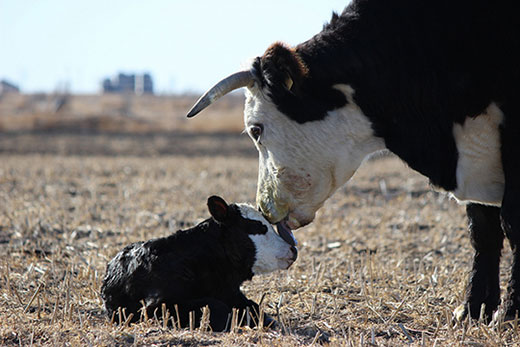
K-State Research and Extension beef veterinarian A.J. Tarpoff urges producers to plan now for a successful spring calving season.| Download this photo.
K-State’s Tarpoff: Plan now to assure successful calving season
Stocking supplies, cleaning equipment are among management strategies
February 11, 2020
MANHATTAN, Kan. – Cattle producers who have not yet started the spring calving season still have time to plan ahead, and a Kansas State University veterinarian notes that could make a big difference in having a successful year.
“This is the time for a pre-emptive strike,” said A.J. Tarpoff, a beef veterinarian with K-State Research and Extension. “If you haven’t started calving yet on your operation, now is the time to start thinking about what you can do to be ready.”
Tarpoff noted that producers need to make sure they have the necessary supplies on hand, which may require buying or repairing items and facilities. Then, he adds, set in motion a plan to manage the birth of the new calves.
“Calving books are a phenomenal tool,” Tarpoff said. “It could be just a little pocketbook where you write down who calved, when they calved, if there was difficulty, and whether it was a male or female coming out. There is a lot of information that we can capture about the birthing process so that we’re able to make better decisions within our herd in the future.”
One of the newer management techniques that can lead to successful calving is to feed cows at dusk. “There have been several research studies that show reliable results that a higher percentage of animals are born during daylight hours when we feed the cow in the late evening hours,” Tarpoff said.
Feeding late in the evening, he said, will help decrease midnight or early morning births, which are hard on workers and can make the birth more complicated if there are difficulties.
Tarpoff hosted a series of calving schools across Kansas over the last several weeks to help the state’s producers be adequately prepared to bring in as many healthy animals as possible. The final session for this season was video-streamed on Facebook Live. A recording of that session can be seen on the K-State Research and Extension Facebook page.
One of his recommendations is that producers use a cooler to store tools and equipment: “On cold days and nights, the cooler will help equipment to stay nice and warm. We can close it up and know that our equipment is not going to freeze,” he said.
Tarpoff said producers should check calving chains or obstetric straps for rust, sharp spots or fraying. He also suggests having multiple sets on hand in case there are multiple births at once. The straps should be cleaned, disinfected and hung to dry after each use.
“Once those straps are dried, put them in a closed container so that you don’t re-contaminate them by accident,” he said. “Then, throw them back into your cooler kit.”
Producers should have a meeting with their local veterinarian to discuss situations that may occur, and what medicine or other supplies may be needed to handle those. “They can prescribe the products you’ll need and set you up to be a little more prepared,” Tarpoff said.
Producers can also contact their local extension agent or visit KSUBeef.org for more information on getting prepared for spring calving.

